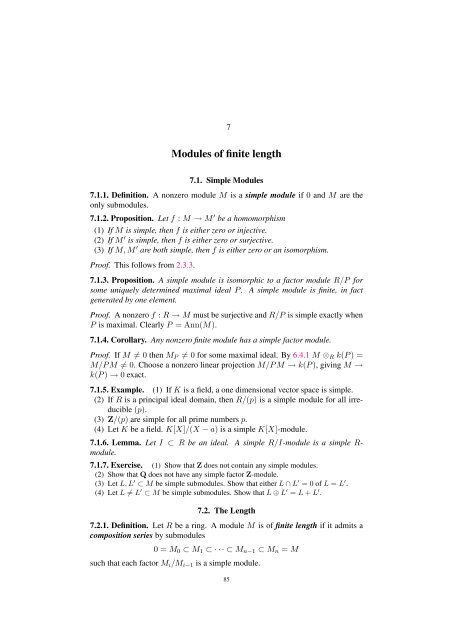Commutative algebra - Department of Mathematical Sciences - old ...
Commutative algebra - Department of Mathematical Sciences - old ...
Commutative algebra - Department of Mathematical Sciences - old ...
Create successful ePaper yourself
Turn your PDF publications into a flip-book with our unique Google optimized e-Paper software.
7<br />
Modules <strong>of</strong> finite length<br />
7.1. Simple Modules<br />
7.1.1. Definition. A nonzero module M is a simple module if 0 and M are the<br />
only submodules.<br />
7.1.2. Proposition. Let f : M → M ′ be a homomorphism<br />
(1) If M is simple, then f is either zero or injective.<br />
(2) If M ′ is simple, then f is either zero or surjective.<br />
(3) If M, M ′ are both simple, then f is either zero or an isomorphism.<br />
Pro<strong>of</strong>. This follows from 2.3.3.<br />
7.1.3. Proposition. A simple module is isomorphic to a factor module R/P for<br />
some uniquely determined maximal ideal P . A simple module is finite, in fact<br />
generated by one element.<br />
Pro<strong>of</strong>. A nonzero f : R → M must be surjective and R/P is simple exactly when<br />
P is maximal. Clearly P = Ann(M).<br />
7.1.4. Corollary. Any nonzero finite module has a simple factor module.<br />
Pro<strong>of</strong>. If M = 0 then MP = 0 for some maximal ideal. By 6.4.1 M ⊗R k(P ) =<br />
M/P M = 0. Choose a nonzero linear projection M/P M → k(P ), giving M →<br />
k(P ) → 0 exact.<br />
7.1.5. Example. (1) If K is a field, a one dimensional vector space is simple.<br />
(2) If R is a principal ideal domain, then R/(p) is a simple module for all irreducible<br />
(p).<br />
(3) Z/(p) are simple for all prime numbers p.<br />
(4) Let K be a field. K[X]/(X − a) is a simple K[X]-module.<br />
7.1.6. Lemma. Let I ⊂ R be an ideal. A simple R/I-module is a simple Rmodule.<br />
7.1.7. Exercise. (1) Show that Z does not contain any simple modules.<br />
(2) Show that Q does not have any simple factor Z-module.<br />
(3) Let L, L ′ ⊂ M be simple submodules. Show that either L ∩ L ′ = 0 <strong>of</strong> L = L ′ .<br />
(4) Let L = L ′ ⊂ M be simple submodules. Show that L ⊕ L ′ = L + L ′ .<br />
7.2. The Length<br />
7.2.1. Definition. Let R be a ring. A module M is <strong>of</strong> finite length if it admits a<br />
composition series by submodules<br />
0 = M0 ⊂ M1 ⊂ · · · ⊂ Mn−1 ⊂ Mn = M<br />
such that each factor Mi/Mi−1 is a simple module.<br />
85
















